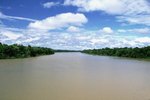
Polar bears are the largest bear in the bear family. They are huge, formidable animals that can stand ten feet tall. They have no natural predators, and their place on the food chain is at the very top. They are listed "threatened" under the Endangered Species Act. The polar bear is the quintessential carnivore and spends most of its time on ice fields.
Polar Bear Coat

The polar bear is a beautiful creature with a very unusual coloration. His fur appears white, but it is actually colorless, or clear. The hair shafts are not only transparent, but also hollow. This causes the light to reflect off his coat causing it to appear white. If this is confusing to you, think of ice and snow. Each flake is clear, but when there's a lot of it, it's white. His coat is very dense, with an undercoat and other hairs of various lengths. He molts, or sheds, annually and when he has a brand new coat and is clean, he is a stunning sight to see in the sunlight. Polar bears in captivity have been known to take on a greenish hue due to algae blooms in their habitat. They can also appear yellowish as a consequence of eating seals with fatty, yellowish blubber.
Polar Bear Body

The polar bear is incredibly strong and heavy. The adult male can weigh an average of 900 to 1,500 pounds. The largest bear ever observed was 2,210 pounds. On average, polar bears stand about about eight feet tall but can reach up to ten feet when fully erect. Adult female polar bears weigh between 330 to 650 pounds. Within the past few decades, however, scientists have been observing thinner polar bears than ever before due to a lack of food.
Polar bears are perfectly suited to living in the extreme temperatures of the Artic. Their thick furs and large paws help them survive and thrive on the ice fields and in the water. For a land animal, the polar bear is an incredibly agile swimmer. His semi-webbed paws can be a foot in diameter and are equipped with large, curved sharp claws. He has tiny ears and a very small tail.
Polar Bear's Range
Polar bears live in Alaska, Canada, Greenland, Norway and Russia. There are 19 known colonies of polar bears and they are located in Canada's Hudson Bay and Lancaster Sound, the Southern Beaufort Sea along the coast of Alaska and Canada, Greenland's Baffin Bay, Kane Basin and Davis Strait, the Norwegian Bay and Svalbard Archipelago in Norway and the Chukchi Sea in Russia. Scientists at the International Union for Conservation of Nature estimate there are only about 20,000 to 25,000 polar bears left.
Polar Bear's Habitat
Polar bears spend almost all their time on the ice fields and in the water hunting for seals, their favorite prey. They depend on ice floes to serve as way stations while they are hunting in the water. They can swim for very long distances, but can drown if they don't find an ice floe on which to rest. The females build their dens on land, but have been known to build dens in snow drifts on ice as well. It's very cold where they live, and temperatures can drop as low as -50 degrees Fahrenheit, but their bodies are well-suited to the climate. The IUCN estimated that In 2012, loss of ice in the Arctic was larger than the size of the United States." The polar bear is in danger and on the road to extinction due to climate change, poaching and environmental dangers.
References
Resources
Photo Credits
-
Jupiterimages/Photos.com/Getty Images
Writer Bio
Michelle A. Rivera is the author of many books and articles. She attended the University of Missouri Animal Cruelty School and is certified with the Florida Animal Control Association. She is the executive director of her own nonprofit, Animals 101, Inc. Rivera is an animal-assisted therapist, humane educator, former shelter manager, rescue volunteer coordinator, dog trainer and veterinary technician.



